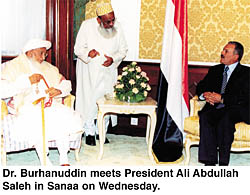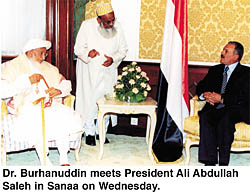
Burhanuddin visits Yemen [Archives:2002/27/Front Page]
July 1 2002

During his visit to Yemen Mohammed Burhanuddin saw some charitable projects which he finances such as water projects, the uproot Qat campaign, livestock and bee keeping projects. He also visited the tombs of some Bohras distinguished leaders and his followers residing in Yemen.
Recently, the Bohra sect in Yemen has waged war against Qat and its cultivation. The representative of the Sultan of Bohra to Yemen has established a nursery which contains different transplants of banana and coffee trees.
Dr. Burhanuddin is invested with full and absolute power to be the sole deputy and vice-regent of the Imam on earth (who is in seclusion). Dr. Mohammed Burhanuddin Sahib is also the spiritual leader of the Dawodi Bohra community.

The Dawdi Bohra community has largely been modeled into its present forms by the two Dais who have led the community in the 12th century. The first Dai, the celebrated Dr. Sayyadina Tahir Saifuddin (1955-1965) was a scholar, prolific writer, a poet, a capable organizer and a man of vision. During his period of 50 years, he revitalized the community and guided it through the tumultuous period of the World Wars and the independence of nations.
The present Dai, Dr. Sayyadina, Mohammed Burhanuddin has continued his predecessors endeavors with particular emphasis on strengthening the communitys Islamic practices and on the promotion of its Fatimid heritage.
There is a strong learning tradition amongst the Dawdi Bohras, their Dais usually prolific writers and orators. The Dawdi Bohras number about a million and reside in India, Pakistan, the Middle East, East Africa, and the West.
——
[archive-e:27-v:2002-y:2002-d:2002-07-01-p:./2002/iss27/front.htm]


